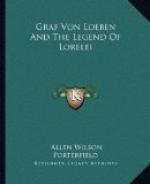[57] These numbers are in the Columbia Library.
[58] During these years Heine’s letters are
dated from GOettingen,
Berlin, Gnesen, Berlin, MUenster,
Berlin, LUeneburg, Hamtburg,
RitzenbUettel, and LUeneburg.
During these same years Loeben was in
Dresden and he was ill.
[59] We need only to mention such a strophe as the
following from
Atta Troll:
Klang das
nicht wie JugendtrAeume.
Die ich trAeumte
mit Chamisso
Und Brentano
und Fouque
In den blauen
MondscheinnAechten?
See Elster edition, II, 421. The lines were written in 1843.
[60] The first edition of Karl Simrock’s Rheinsagen
came out in
1836. This was not accessible.
The edition of 1837, “zweite,
vermehrte Auflage,”
contains 168 poems, 572 pages; this contains
Simrock’s “Ballade
von der Lorelei.” The edition of 1841 also
contains Simrock’s “Der
Teufel und die Lorelei.” The book contains
455 pages, 218 poems.
The sixth edition (1809) contains 231 poems.
In all editions the poems
are arranged in geographical order from
SUedersee to GraubUenden.
Alexander Kaufmann’s Quellenangaben und
Bemerkungen zu Kart Simrocks
Rheinsagen throws no new light on
the Lorelei-legend.
[61] Cf. Heinrich Heines sAemtliche Werke,
edited by Walzel,
FrAenkel, KrAehe, Leitzmann,
and Peterson. Leipzig. 1911, II,
408. So far as I have
looked into the matter, Walzel stands alone
in this belief, though MUecke,
as has been pointed out above,
anticipated him in the statement
that Heine drew on Schreiber in
this case. But MUecke
thinks that Heine also knew Loeben.
[62] The reference in question reads as follows:
“Ich will kein Wort
verlieren Ueber den Wert dieses
unverdaulichen Machwerkes [Les
Burgraves], das mit allen
mOeglichen PrAetensionen auftritt,
namentlich mit historischen,
obgleich alles Wissen Victor Hugos
Ueber Zeit und Ort, wo sein
StUeck spielt, lediglich aus der
franzOesischen Uebersetzung
von Schreibers Handbuch fUer
Rheinreisende geschOepft,
ist.” This was written March 20, 1843
(see Elster edition, VI. 344).
[63] Aloys Wilhelm Schreiber (1763-1840) was a teacher
in the Lyceum
at Baden-Baden (1800-1802),
professor of aesthetics at Heidelberg
(1802-13) where he was intimate
with the Voss family,
historiographer at Karlsruhe
(1813-26), and in 1826 he retired and
became a most prolific writer.
He interested himself in guidebooks
for travelers. His manuals
contain maps, distances, expense
accounts, historical sketches,
in short, about what the modern
Baedeker contains with
fewer statistics and more popular
description. His books
appeared in German, French, and




